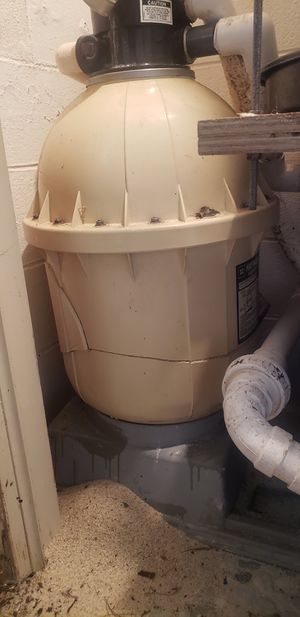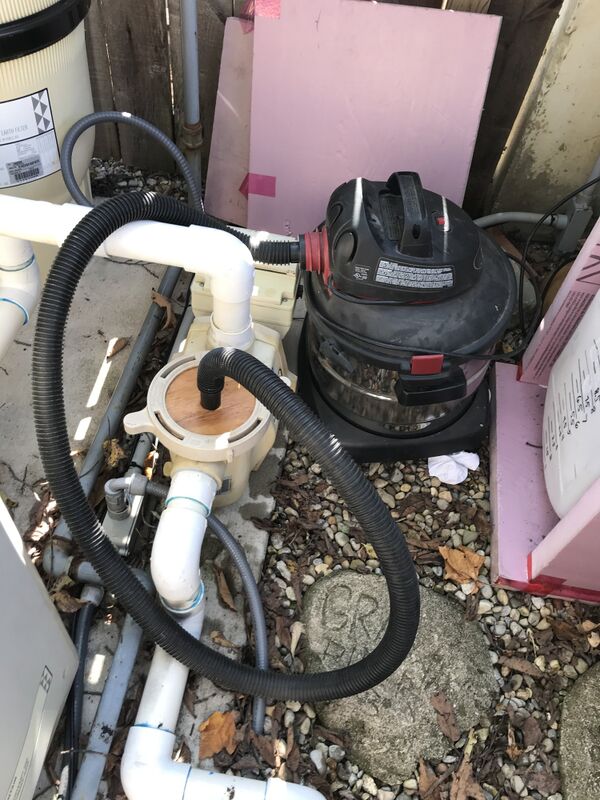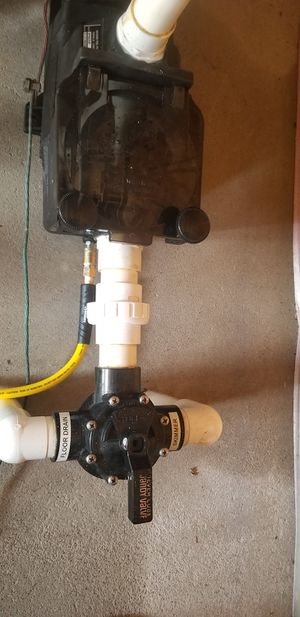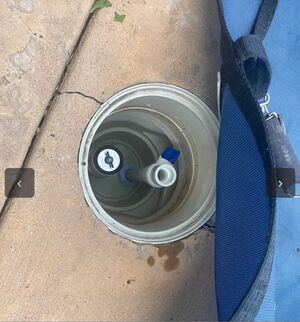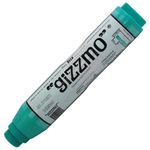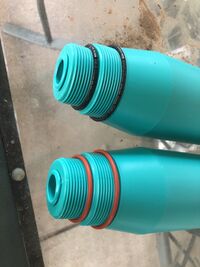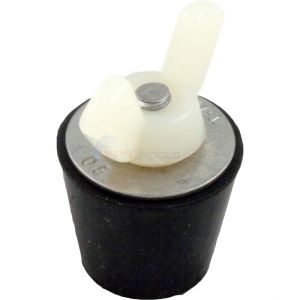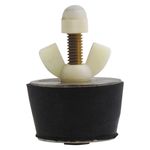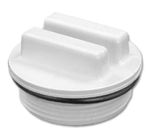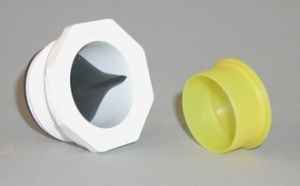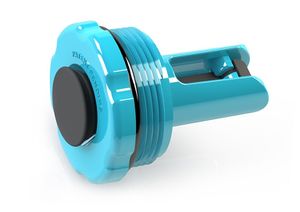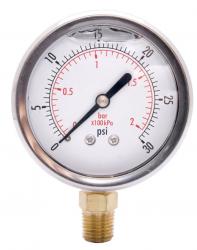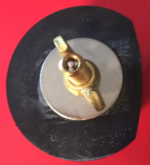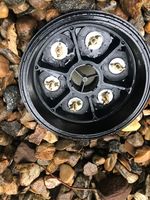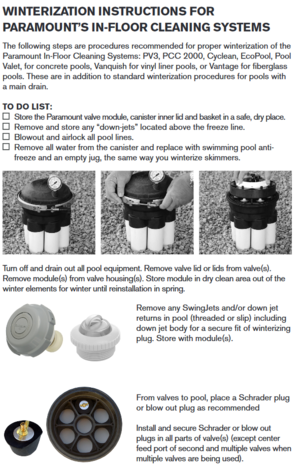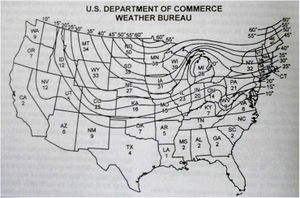| (63 intermediate revisions by 4 users not shown) | |||
| Line 1: | Line 1: | ||
=How to Close a Pool for the Winter= | =How to Close a Pool for the Winter= | ||
| + | [[File:Cracked Filter from Freezing.jpg|thumb]] | ||
| + | The picture to the right shows what happened to a sand filter that was not properly blown out and winterized for the winter. | ||
==How to Close an Above Ground Pool== | ==How to Close an Above Ground Pool== | ||
| − | [https://www.troublefreepool.com/content/145-closing-winterizing-your-above-group-pool Closing your Above Ground Pool] in TFP Pool School. | + | When the pool season ends, you can leave it up and winterize it as seen in [https://www.troublefreepool.com/content/145-closing-winterizing-your-above-group-pool Closing your Above Ground Pool] in TFP Pool School. |
| + | |||
| + | You can also decide to take the pool down and store it. If you do, be sure to drain and clean the pool, then store the liner and frame in a dry place. If you are able, store the pool inside or large receptacle for storage. | ||
| + | |||
| + | Be aware often, when pulling it out of the garage for the next pool season, people have discovered small holes from rodents chewing through the vinyl or even reports of mice families using it as home! | ||
| + | |||
| + | Additionally, cover the leveled area with a heavy-duty tarp to inhibit animals using it as a bathroom, and secure the tarp with additional cement pavers. If you have a pump, be sure it is completely drained and stored out of the elements. | ||
==How to Close an In-Ground Pool== | ==How to Close an In-Ground Pool== | ||
[https://www.troublefreepool.com/content/146-closing-an-in-ground-pool Closing Your In-Ground Pool] in TFP Pool School. | [https://www.troublefreepool.com/content/146-closing-an-in-ground-pool Closing Your In-Ground Pool] in TFP Pool School. | ||
| + | |||
| + | [https://www.youtube.com/watch?v=hQZeRqZAyu8 How to Close an Inground Pool Using the Cyclone Blower] was done my member @poolgate showing how he closes his pool that has a main drain using a modified pump lid and cyclone blower. | ||
[https://www.troublefreepool.com/threads/the-concept-of-closing-an-in-ground-swimming-pool.150693/ The concept of closing an in ground swimming pool] | [https://www.troublefreepool.com/threads/the-concept-of-closing-an-in-ground-swimming-pool.150693/ The concept of closing an in ground swimming pool] | ||
| Line 12: | Line 22: | ||
[https://www.troublefreepool.com/threads/safety-cover-and-water-levels.153612/post-1358909 Winterizing Paramount's In-Floor Cleaning System]. | [https://www.troublefreepool.com/threads/safety-cover-and-water-levels.153612/post-1358909 Winterizing Paramount's In-Floor Cleaning System]. | ||
| + | |||
| + | [https://www.youtube.com/watch?v=HkVVJnfosDg/ TFP Video Discussion on Winterizing] | ||
==How To Use Polyquat 60 in Pool Winterization== | ==How To Use Polyquat 60 in Pool Winterization== | ||
| Line 30: | Line 42: | ||
*Make sure you get the correct 6' hose. | *Make sure you get the correct 6' hose. | ||
| − | [https://www.troublefreepool.com/threads/modified-cover-for-hayward-super-pump-for-closing-swimming-pool.101429/ Modified Cover for Hayward Super Pump for Closing Swimming Pool] gives more details on the process. | + | [https://www.troublefreepool.com/threads/modified-cover-for-hayward-super-pump-for-closing-swimming-pool.101429/ Modified Cover for Hayward Super Pump for Closing Swimming Pool] and [https://www.troublefreepool.com/threads/how-to-modify-drill-your-pump-basket-lid-to-accept-a-blower.283524/ How To: Modify (Drill) Your Pump Basket Lid to Accept a Blower] gives more details and a video on the process. |
| + | |||
| + | One creative member used the pump lid housing, replacing the clear pump lid with a piece of 1/2" plywood with a hole to connect the blower hose to. The thickness of the plywood is equal to that of the lid and gasket, it seals good enough to get the job done. | ||
| + | |||
| + | [[File:Pump Blower Cover Plywood Connection.jpg|600px|frameless]] | ||
| + | |||
| + | You can find more pics of the plywood lid in [https://www.troublefreepool.com/threads/cyclone-connection-to-swg-unions.241292/#post-2114330 this thread]. | ||
===Connecting Compressor to Pump Using Drain Port=== | ===Connecting Compressor to Pump Using Drain Port=== | ||
| Line 46: | Line 64: | ||
Bursting due to air pressure is a non-issue. Typical 2" plumbing has a bursting pressure of 890 psi. Glue joints, if done properly should be just as strong if not stronger than the pipe itself because of the double thickness of the pipe wall at the joint.<ref>https://www.troublefreepool.com/threads/blowing-out-main-drain-friendly-debate.107407/post-941666</ref> | Bursting due to air pressure is a non-issue. Typical 2" plumbing has a bursting pressure of 890 psi. Glue joints, if done properly should be just as strong if not stronger than the pipe itself because of the double thickness of the pipe wall at the joint.<ref>https://www.troublefreepool.com/threads/blowing-out-main-drain-friendly-debate.107407/post-941666</ref> | ||
| + | |||
| + | The [https://www.airsupplyflorida.com/wp-content/uploads/2017/12/Cyclone-Pro-Flyer-Air-Supply-of-the-Future-Inc.pdf Cyclone Blower] will generate about 160 to 180 inches of water pressure, which is about 5.8 to 6.5 psi. 180 inches is 15 feet. So, that's the maximum water depth that it can blow out. | ||
| + | |||
| + | ==Pool Antifreeze vs. RV Antifreeze: What’s the Difference?== | ||
| + | |||
| + | Pool and Marine RV antifreeze should be propylene glycol. It may also contain Ethyl Alcohol (Ethanol) or Glycerol.<ref>https://www.troublefreepool.com/threads/pool-antifreeze-vs-rv-antifreeze-whats-the-difference.273753/</ref> | ||
| + | |||
| + | Engine coolant is different from Marine Antifreeze. It is usually Ethylene Glycol and should not be used in pools. | ||
| + | |||
| + | RV antifreeze is primarily used to winterize all types of portable water systems including; boats, trailers, recreational vehicles, vacation homes and swimming pool/spa filtration and heating systems. RV antifreeze is not designed for long-term protection or for use on operating engines. | ||
| + | |||
| + | It is always best to verify the product is specifically designed for pool use by looking at the manufacturer's site or looking on the label to see the recommended uses. | ||
==Techniques to Air Lock the Main Drain== | ==Techniques to Air Lock the Main Drain== | ||
| Line 57: | Line 87: | ||
===Foam Rope=== | ===Foam Rope=== | ||
If the main drain is connected to a hole in a skimmer you can push a 4’ piece of foam rope into the hole and be done with it.<ref> https://www.troublefreepool.com/threads/air-lock-on-main-drain.194948/post-1718724</ref> It takes patience and good fingers to push against the water pressure. Then plug the hole with the foam rope in. Hold the plug down with your pinky while using thumb and index to push the rope in. | If the main drain is connected to a hole in a skimmer you can push a 4’ piece of foam rope into the hole and be done with it.<ref> https://www.troublefreepool.com/threads/air-lock-on-main-drain.194948/post-1718724</ref> It takes patience and good fingers to push against the water pressure. Then plug the hole with the foam rope in. Hold the plug down with your pinky while using thumb and index to push the rope in. | ||
| + | |||
| + | You may need to zip tie the noodle/rope to a dowel as it pushes back after a couple of inches. | ||
| + | |||
| + | ===Skimmer Main Drain Pipe Airlock Valve=== | ||
| + | |||
| + | Use a reducer to a 1 inch pipe and ball valve to be able to blow air into the main drain pipe and then air lock it.<ref>https://www.troublefreepool.com/threads/issues-with-blowing-out-main.284939/post-2496609</ref> | ||
| + | |||
| + | [[File:Winterization Airlock Skimmer Main Drain Pipe.jpg|thumb]] | ||
==Winterizing the Skimmer== | ==Winterizing the Skimmer== | ||
Once the skimmer lines are blown out the objective is to displace water from the skimmer so that if ice forms in it the ice has room to expand up. Ice does not expand more than 9% and will go upward in the skimmer.<ref>https://www.troublefreepool.com/threads/help-needed-winterize-inground-pool-skimmer.195126/post-1719867</ref> | Once the skimmer lines are blown out the objective is to displace water from the skimmer so that if ice forms in it the ice has room to expand up. Ice does not expand more than 9% and will go upward in the skimmer.<ref>https://www.troublefreepool.com/threads/help-needed-winterize-inground-pool-skimmer.195126/post-1719867</ref> | ||
| − | People fill the skimmer with one or more of the methods below. | + | People fill the skimmer with one or more of the methods below to provide a crush zone so if the water freezes the 9% expansion simply crushes the plastic or foam instead of cracking the skimmer. |
===Gizzmos=== | ===Gizzmos=== | ||
| Line 70: | Line 108: | ||
Some Gizzmos have a a blowout valve on the top in the top to blow out lines. If you have a Gizzmo that has an opening at the top and air is coming out of the threaded area, then the threads on the Gizmo may be stripped. | Some Gizzmos have a a blowout valve on the top in the top to blow out lines. If you have a Gizzmo that has an opening at the top and air is coming out of the threaded area, then the threads on the Gizmo may be stripped. | ||
| + | |||
| + | A member had the black rubber gaskets crack after one season and replaced them with silicone versions (tan) that may last a bit longer:<ref>https://www.troublefreepool.com/threads/replacement-gaskets-for-skimmer-gizzmo.243785/</ref> | ||
| + | |||
| + | *[https://www.mcmaster.com/1173N224/ High-Temperature Soft Silicone O-Ring Width-1/8,ID-1 3/4,OD-2] | ||
| + | *[https://www.mcmaster.com/1173N228/ High-Temperature Soft Silicone O-Ring Width -1/8,ID-2 1/4,OD-2 1/2] | ||
| + | |||
| + | [[File:Gizzmo gaskets.jpg|200px|thumb]] | ||
===Pool Noodles=== | ===Pool Noodles=== | ||
| Line 78: | Line 123: | ||
===Plastic Bottles=== | ===Plastic Bottles=== | ||
| − | *one liter plastic bottle filled up half way with antifreeze is fine | + | *one liter plastic bottle filled up half way with pool/RV (not automotive) antifreeze is fine |
*drop into the skimmers a plastic water bottle filled half way with windshield washer fluid. | *drop into the skimmers a plastic water bottle filled half way with windshield washer fluid. | ||
| − | *use a gallon jug of Antifreeze with about 1/4 left in the jug. It fits in a skimmer perfect, and add a little antifreeze to the skimmer box | + | *use a gallon jug of pool/RV (not automotive) Antifreeze with about 1/4 left in the jug. It fits in a skimmer perfect, and add a little pool/RV (not automotive) antifreeze to the skimmer box |
| + | |||
| + | ==Winterizing Heaters== | ||
| + | |||
| + | Follow the winterizing instructions in the heater installation manual. Different model heaters have different winterizing instructions. | ||
| + | |||
| + | [https://www.youtube.com/watch?v=T9rnqHR-y6k&t=156s Raypak® Winterizing for Gas Fired Heaters - Training Video] | ||
==Winterization Plugs== | ==Winterization Plugs== | ||
| Line 87: | Line 138: | ||
===Rubber Expansion Plugs=== | ===Rubber Expansion Plugs=== | ||
[[File:Rubber Expansion plug.jpg|thumb]] | [[File:Rubber Expansion plug.jpg|thumb]] | ||
| − | Tapered rubber winter expansion plugs with a wingnut to tighten come in various | + | Tapered rubber winter expansion plugs with a wingnut to tighten come in various sizes: |
*0 - 1/2" pipe tapered | *0 - 1/2" pipe tapered | ||
| Line 107: | Line 158: | ||
===Blow-Thru Valve Winter Pool Plugs=== | ===Blow-Thru Valve Winter Pool Plugs=== | ||
| + | [[File:Winter Plug with Blow-Thru Valve.jpg|150px|thumb]] | ||
| + | [https://www.troublefreepool.com/threads/blow-thru-valve-winter-pool-plugs.174703/ Blow-Thru Valve Winter Pool Plugs] are tapered rubber plugs with a Schrader valve stem. | ||
| − | + | Most members with an air compressor usually connect an NPT fitting to the pump basket, then clear the lines with an air compressor, or they create some adapter and work from the skimmers, unions, etc. If you are working on the return side, this would mean that you will have to isolate the suction side to create enough air volume to accomplish the task and vice versa.<ref> https://www.troublefreepool.com/threads/blow-thru-valve-winter-pool-plugs.174703/ </ref> | |
| + | |||
| + | With the blow thru plugs, one can simply place in a the pump basket housing, and use an air compressor to move water with air. This method would only require 2 plugs and an air compressor (One on the return side and one on the suction side) | ||
| + | |||
| + | They are also useful for blowing out pipes, such as a main drain, where you don’t have a valve. | ||
===Threaded Return Line Plugs=== | ===Threaded Return Line Plugs=== | ||
| Line 120: | Line 177: | ||
This 1 1/2" threaded plug can also replace the drain plug in XtremepowerUS, Hayward and Pentair filter tanks | This 1 1/2" threaded plug can also replace the drain plug in XtremepowerUS, Hayward and Pentair filter tanks | ||
| − | . | + | ===Winter Duck Plugs=== |
| + | [[File:Duck Plug Anderson Manufacturing.jpg|thumb]] | ||
| + | [https://www.leaktools.com/winterizing.html Winter Duck Plug] (fits 1-1/2" Threads) is a one-way pool "duck-bill" valve allowing a large flow of air and water to be blown from the return plumbing but does not allow water back into the lines. | ||
| + | |||
| + | The double-seal system provides a water tight seal at the face plate or inside the fitting. The Winter Duck Plug provides adequate back pressure to allow all returns to be cleared at the same time without "burping." Once all the returns have been bubbling for several minutes you turn off the blower. Water will not enter the pipes from the pool.<ref> https://www.leaktools.com/winter-duck-plug-fits-1-12-threads.html </ref> | ||
| + | |||
| + | ===Bungee-Plug=== | ||
| + | [[File:Bungee-Plug.jpg|thumb]] | ||
| + | The [https://bungeeplug.com/#works Bungee-Plug] is a one-way valve with a bungee strap that stretches to allow air or water to flow freely when pressure is applied. The bungee strap responds instantly to pressure relief and seals with a unique triple O-ring seal. | ||
| + | |||
| + | The Bungee-Plug replaces the return eyeball, and there's a hole in the center that's plugged with a rubber stopper that's held in place by a strap coming off of the back of it. When you blow air through the system, the strap stretches allowing air to exit. As soon as the pressure is removed from the backside, the strap contracts, and the hole is plugged, sealing the return from water.<ref> https://www.troublefreepool.com/threads/bungee-plugs-anyone-ever-used-these.153172/post-1354700</ref> | ||
| + | |||
| + | ==Winterizing a Cartridge Filter== | ||
| + | |||
| + | *The drain plug should be removed and the filter drained for the winter | ||
| + | *The PSI gauge should be removed and taken indoors | ||
| + | *Cartridges should be removed and cleaned | ||
| + | *Cartridges should be stored indoors, not in the filter, and reinstalled at opening | ||
| + | |||
| + | ==Removing the Filter Pressure Gauge== | ||
| + | [[File:Pressure Gauge.jpg|thumb]] | ||
| + | Depending on the type of oil/filler in the gauge, often times they get stuck or their calibration gets thrown off. [https://tftestkits.net/cart.html TFTestkits] has very good [https://tftestkits.net/flow-meters-and-psi-gauges-c12/ glycerin-filled gauges] that is freeze protected to -4º F. | ||
| + | |||
| + | Even then, it's easy to be safe and unscrew the gauge during closing, then just re-attach it in the spring with a 2-3 wraps of Teflon tape.<ref> https://www.troublefreepool.com/threads/remove-gage-when-closing.195301/post-1721607 </ref> | ||
| + | |||
| + | What can happen is that a small amount of water gets into the bourdon tube and due to the orientation of the gauge (especially back mount gauges) it doesn't drain out so during a freeze. The water freezes and deforms the tube causing the gauge to read incorrectly or not at all. This is especially true for back mounted gauges mounted vertically.<ref> https://www.troublefreepool.com/threads/remove-gage-when-closing.195301/post-1721661</ref> | ||
| + | |||
| + | Some filters use back mounted gauges mounted horizontally recessed into the top housing and those aren't as susceptible to holding water in them. Also, bottom mounted gauges mounted vertically nipple down, aren't as prone to holding water in them. | ||
| + | |||
| + | Some pressure gauges are cheap and can be replaced in the spring. Removed or not the cheap ones rarely last a year.<ref> https://www.troublefreepool.com/threads/remove-gage-when-closing.195301/post-1721668 </ref> | ||
| + | |||
| + | ==Winterizing Paramount In-Floor Cleaning system== | ||
| + | [[File:Paramount plug.png|150px|thumb]] | ||
| + | Manuals for the IFCS and other Paramount products are at [http://www.1paramount.com/downloads/manuals/062415WinterizationManualForWebsite.pdf Winterizing Proceedures For: Paramount Pool Products] and [http://forms.1paramount.com/products/winter.pdf WINTERIZATION INSTRUCTIONS FOR PARAMOUNT’S IN-FLOOR CLEANING SYSTEMS] | ||
| + | |||
| + | Paramount makes a proprietary shaped cylindrical plug with one flat side to fit the water valve with schrader valve - [https://www.infloorpoolparts.com/paramount-set-of-winterizing-plugs.html Paramount Set of 1-1/2" or 2" Winterizing Plugs (6 Pack) 004-302-1672-00]. | ||
| + | [[File:Paramount IFCS plugged.jpg|150px|thumb]] | ||
| + | [https://www.troublefreepool.com/threads/safety-cover-and-water-levels.153612/post-1358913 This thread] has a discussion about closing the Paramount IFCS. | ||
| + | |||
| + | [[File:Paramount In-Floor Cleaning system Winterization.png|frameless|center]] | ||
| + | |||
| + | *Turn off and drain out all pool equipment. Remove valve lid or lids from valve(s). Remove module(s) from valve housing(s). Store module in dry clean area out of the winter elements for winter until reinstallation in spring. | ||
| + | *Remove any SwingJets and/or down jet returns in pool (threaded or slip) including down jet body for a secure fit of winterizing plug. Store with module(s). | ||
| + | *From valves to pool, place a Schrader plug or blow out plug as recommended | ||
| + | *Install and secure Schrader or blow out plugs in all parts of valve(s) (except center feed port of second and multiple valves when multiple valves are being used | ||
| + | *Proceed to blow out lines through Schrader or blow out plugs to pool. | ||
| + | *While blowing out the in-floor nozzles, once a good amount of air has come through the nozzle, you have accomplished an air lock. (This procedure is similar to obtaining an air lock when blowing out the bottom drain in the pool.) | ||
| + | *Blow out center port of first valve back to filter equipment and plug. | ||
| + | *While blowing out the down jets and while air is escaping through the in-wall hole, install and secure a regular winterizing plug. | ||
| + | *Repeat until all ports are blown out.In cases where multiple valves are in use, blow out the feeder port of the first valve into the center port of the second or multiple valve(s), install, and secure plug. | ||
| + | *When necessary, pool winter anti-freeze solution should be poured into each line. | ||
| + | *Valve housing(s) should be wiped clean and dry of water, reinstall top lid and secure | ||
| + | |||
| + | ===Tips=== | ||
| + | *Look at the water valve risers for pipe size & check for reducers/bushings<ref>https://www.troublefreepool.com/threads/safety-cover-and-water-levels.153612/post-1359997</ref> | ||
| + | *Don't be a cheapskate & grind down a schrader plug, it will fall down the pipe | ||
| + | *You will need to remove the floor heads for those that are too shallow to airlock & insert #12, for these a cyclone will do since they get plugged | ||
| + | *Buy the paramount removal wrench, a couple seasons removing with improvised tools & heads will be mangled | ||
| + | *For the deeper ports that must be airlocked, compressor is mandatory. Pour a little pool/RV (not automotive) antifreeze on top of plug, to make sure no bubbles- usually takes about 4 cranks beyond hand tight to seal these plugs | ||
| + | *That will get you through the paramount pressure side, if you have a true system there is more fun to be had on the suction side of this | ||
| + | *Getting into features like these it's best to have a pro do it | ||
| + | *These repairs are big bucks & failures are discovered at apex of the busy season | ||
| + | |||
| + | ==Closing Pool With an Autocover== | ||
| + | |||
| + | Auto-covers are designed to rest on the pool water. You will damage the auto-cover if you drain the pool and close the auto-cover.<ref> https://www.troublefreepool.com/threads/drain-water-with-automatic-cover.194370/post-1713556</ref> | ||
| + | |||
| + | If you are going to drain, you must fully open the auto-cover and use a separate winter cover for the off season. | ||
| + | |||
| + | ==Closing Pool With Safety Cover== | ||
| + | |||
| + | [[Pool Covers|Safety covers]] are not designed to take the full weight of snow and the water level has to be maintained as per manufacturers instructions or the cover can become overloaded and damaged. | ||
| + | |||
| + | Some cover manufactures recommend that the water level is not more than 12" below the deck. Others say up to 18". Check your cover manufacturers recommendations.<ref>http://www.glipoolproducts.com/Manuals/Instructions/SafetyCover_Instructions_Website.pdf</ref><ref>https://www.propools.com/Manuals/54459_2014922114330.pdf</ref> | ||
| + | |||
| + | Meyco says<ref>https://meycocovers.com/support/winterize-storage/</ref>: | ||
| + | |||
| + | ''Reduce the load – Meyco covers are very sturdy, however in cases of extreme snow load keeping the water level within 18” of the top of the pool is very important to reduce the stress on the cover and protect it from damage.'' | ||
| + | |||
| + | LoopLoc says: | ||
| + | [[File:LoopLoc Safty Cover Warning.png|thumb]] | ||
| + | |||
| + | ==Plugging the Skimmer Door== | ||
| + | If you blow out the skimmer line and need to leave the water up to the skimmer due to water supporting the cover or a vinyl liner then use a skimmer plug or an [http://www.aquadors.com/ aquadoor skimmer faceplate] to close off the skimmer.<ref> https://www.troublefreepool.com/threads/drain-water-with-automatic-cover.194370/post-1722623</ref> | ||
| + | |||
| + | =Freezing Precautions= | ||
| + | |||
| + | ==When do Pipes Begin Freezing== | ||
| + | |||
| + | Read [https://www.troublefreepool.com/threads/the-physics-of-freezing-and-freeze-protection.86914/ The Physics of Freezing and Freeze Protection]. | ||
| + | |||
| + | ==What Depth is Safe From Freezing== | ||
| + | |||
| + | Consult the Frost Line map for your area. | ||
| + | |||
| + | [[File:Frost Line Map.jpg|frameless|center]] | ||
| + | |||
| + | ==Ice Shelves== | ||
| + | Depending on your geographic location, some pools experience extremely harsh winters. The consistently cold/freezing temperatures result in the development of an ice shelf on the water's surface. | ||
| + | |||
| + | It is generally advised not to break or disturb that ice shelf once formed. Disturbing the ice shelf can result the ice shelf and/or broken pieces shifting within the pool thereby damaging the shell. | ||
| + | |||
| + | This is particularly important for pools with a vinyl liner that can tear easily by sharp ice. If an ice shelf has formed, it's best to simply leave it until it thaws on its own. | ||
| + | |||
| + | Also with a plaster pool the water level should not be left right at the level of steps or ledges. Water freezing right on the plaster can lift the plaster and damage it. Leave an inch of water above any steps or ledge so that any ice forming will float above the plaster. | ||
Latest revision as of 20:09, 10 March 2024
How to Close a Pool for the Winter
The picture to the right shows what happened to a sand filter that was not properly blown out and winterized for the winter.
How to Close an Above Ground Pool
When the pool season ends, you can leave it up and winterize it as seen in Closing your Above Ground Pool in TFP Pool School.
You can also decide to take the pool down and store it. If you do, be sure to drain and clean the pool, then store the liner and frame in a dry place. If you are able, store the pool inside or large receptacle for storage.
Be aware often, when pulling it out of the garage for the next pool season, people have discovered small holes from rodents chewing through the vinyl or even reports of mice families using it as home!
Additionally, cover the leveled area with a heavy-duty tarp to inhibit animals using it as a bathroom, and secure the tarp with additional cement pavers. If you have a pump, be sure it is completely drained and stored out of the elements.
How to Close an In-Ground Pool
Closing Your In-Ground Pool in TFP Pool School.
How to Close an Inground Pool Using the Cyclone Blower was done my member @poolgate showing how he closes his pool that has a main drain using a modified pump lid and cyclone blower.
The concept of closing an in ground swimming pool
Winterizing Paramount's In-Floor Cleaning System.
TFP Video Discussion on Winterizing
How To Use Polyquat 60 in Pool Winterization
How To Use Polyquat 60 in Pool Winterization?
Connecting Air Through Pump
Modified Pump Cover to Connect Blower for Closing Swimming Pool
A modified pool pump cover can be used to connect the air output from a blower to the plumbing. These modified covers are custom made.
Few tips when making your modified cover:[1]
- Go very slow or you will bind up.
- Clamp it down or it will go for a spin.
- If you order a new lid, use it for the pump and use old one for the modifications.
- Do not not use silicone unless absolutely necessary. The fittings that go thru the lid will have rubber gaskets that would seal it.
- Make sure you get the correct 6' hose.
Modified Cover for Hayward Super Pump for Closing Swimming Pool and How To: Modify (Drill) Your Pump Basket Lid to Accept a Blower gives more details and a video on the process.
One creative member used the pump lid housing, replacing the clear pump lid with a piece of 1/2" plywood with a hole to connect the blower hose to. The thickness of the plywood is equal to that of the lid and gasket, it seals good enough to get the job done.
You can find more pics of the plywood lid in this thread.
Connecting Compressor to Pump Using Drain Port
A compressor can be connected to the 1/4” npt drain port of the pump to blow air into the suction and return lines.
You can then isolate the suction and return side with winter plugs. Plug the return side and work on the suction side. Then plug the suction side and work on the return side.[2]
Remove the lid and inside you will have the ports where the plumbing is attached, both suction and the return side. The suction (Main Drain and Skimmers are toward the shut off valve). The back is the return side. The plugs that will fit are either #8, #9, #10 or # 11. Plug the port inside the housing. Only plug the side you want air NOT to travel.
Or you can use the shut off valves to close off the air traveling towards the skimmers & main drain, but the winter plugs work best. No need to over tighten either, just snug as they are not going anywhere.
How Much Air is Required to Blow Out Lines?
Low pressure and high volume is best to blowing air through the lines. You only need 3.5 psi to clear a pipe 8 ft below water level.
Bursting due to air pressure is a non-issue. Typical 2" plumbing has a bursting pressure of 890 psi. Glue joints, if done properly should be just as strong if not stronger than the pipe itself because of the double thickness of the pipe wall at the joint.[3]
The Cyclone Blower will generate about 160 to 180 inches of water pressure, which is about 5.8 to 6.5 psi. 180 inches is 15 feet. So, that's the maximum water depth that it can blow out.
Pool Antifreeze vs. RV Antifreeze: What’s the Difference?
Pool and Marine RV antifreeze should be propylene glycol. It may also contain Ethyl Alcohol (Ethanol) or Glycerol.[4]
Engine coolant is different from Marine Antifreeze. It is usually Ethylene Glycol and should not be used in pools.
RV antifreeze is primarily used to winterize all types of portable water systems including; boats, trailers, recreational vehicles, vacation homes and swimming pool/spa filtration and heating systems. RV antifreeze is not designed for long-term protection or for use on operating engines.
It is always best to verify the product is specifically designed for pool use by looking at the manufacturer's site or looking on the label to see the recommended uses.
Techniques to Air Lock the Main Drain
Winterizing the main drain, if you have one, depends on the way the main drain is plumbed into your system. You do not, and cannot, clear the main drain of water. What you want to do is clear the water down the pipe until close to or at the frost level. That gives a free column for any water and ice to expand into.
Valves
If your main drain has its own valve it should be air locked with the shut off valve and then the air compressor immediately shut off.
First shut off the main drain to clear skimmers. When done, close skimmers with valve and clear main drain. After bubbling, shut off main drain and then shut off the compressor to not create back pressure.
Foam Rope
If the main drain is connected to a hole in a skimmer you can push a 4’ piece of foam rope into the hole and be done with it.[5] It takes patience and good fingers to push against the water pressure. Then plug the hole with the foam rope in. Hold the plug down with your pinky while using thumb and index to push the rope in.
You may need to zip tie the noodle/rope to a dowel as it pushes back after a couple of inches.
Skimmer Main Drain Pipe Airlock Valve
Use a reducer to a 1 inch pipe and ball valve to be able to blow air into the main drain pipe and then air lock it.[6]
Winterizing the Skimmer
Once the skimmer lines are blown out the objective is to displace water from the skimmer so that if ice forms in it the ice has room to expand up. Ice does not expand more than 9% and will go upward in the skimmer.[7]
People fill the skimmer with one or more of the methods below to provide a crush zone so if the water freezes the 9% expansion simply crushes the plastic or foam instead of cracking the skimmer.
Gizzmos
There are various size Gizzmos for in-ground and above ground pool skimmers. The Gizmo screws into the skimmer line. There are many products similar to the Gizzmo for absorbing the expansion of ice in the skimmer.
The Gizzmo needs teflon tape on the threads to seal well.
Some Gizzmos have a a blowout valve on the top in the top to blow out lines. If you have a Gizzmo that has an opening at the top and air is coming out of the threaded area, then the threads on the Gizmo may be stripped.
A member had the black rubber gaskets crack after one season and replaced them with silicone versions (tan) that may last a bit longer:[8]
- High-Temperature Soft Silicone O-Ring Width-1/8,ID-1 3/4,OD-2
- High-Temperature Soft Silicone O-Ring Width -1/8,ID-2 1/4,OD-2 1/2
Pool Noodles
- pool noodles are made from closed cell foam which doesn't absorb water.
- put 6" of "pool noodle" in the skimmer, just in case rain, snow, etc fills the pool back up
- Cut a 8 inch piece off the end of a noodle. Place it in skimmer.[9]
- If you use pieces of pool noodles along with the Gizzmo's, wrap them around the Gizzmo in a circular fashion. The more you cover, the less water, which means more protection.
Plastic Bottles
- one liter plastic bottle filled up half way with pool/RV (not automotive) antifreeze is fine
- drop into the skimmers a plastic water bottle filled half way with windshield washer fluid.
- use a gallon jug of pool/RV (not automotive) Antifreeze with about 1/4 left in the jug. It fits in a skimmer perfect, and add a little pool/RV (not automotive) antifreeze to the skimmer box
Winterizing Heaters
Follow the winterizing instructions in the heater installation manual. Different model heaters have different winterizing instructions.
Raypak® Winterizing for Gas Fired Heaters - Training Video
Winterization Plugs
Winterizing plugs are used to seal the return and skimmer holes. They can also be used to plug the pump intake and outlet and individual lines during the blowout process.
Rubber Expansion Plugs
Tapered rubber winter expansion plugs with a wingnut to tighten come in various sizes:
- 0 - 1/2" pipe tapered
- 1 - 1/2" pipe
- 2 - 3/4" tube tapered
- 3 - 3/4" pipe
- 4 - 3/4" and 1" pipe
- 5 - 1" pipe
- 6 - 1" fitting
- 7 - 1 1/4" pipe tapered
- 8 - 1 1/2" pipe tapered
- 9 - 1 1/2" pipe and 1 1/4" fitting tapered
- 10 - 1 1/2" fitting tapered
- 11 - 2" pipe
- 15 - 4" pipe
- 16 - 4" pipe
There are also extra long tapered plugs that can cover #7 to #10 sizes.
Blow-Thru Valve Winter Pool Plugs
Blow-Thru Valve Winter Pool Plugs are tapered rubber plugs with a Schrader valve stem.
Most members with an air compressor usually connect an NPT fitting to the pump basket, then clear the lines with an air compressor, or they create some adapter and work from the skimmers, unions, etc. If you are working on the return side, this would mean that you will have to isolate the suction side to create enough air volume to accomplish the task and vice versa.[10]
With the blow thru plugs, one can simply place in a the pump basket housing, and use an air compressor to move water with air. This method would only require 2 plugs and an air compressor (One on the return side and one on the suction side)
They are also useful for blowing out pipes, such as a main drain, where you don’t have a valve.
Threaded Return Line Plugs
A threaded plug with an O ring will screw into return lines to seal them for the winter. It is the Hayward SP1022C 1.5" MPT Plug with O-Ring, White with similar plugs from other manufacturers.
The threaded plugs fit 1 1/2" return fittings. The Hayward SP1419T seat removal tool will remove the directional fitting to plug it during winterization.
Use Teflon tape on the threads and Pool Lube on the O ring.
This 1 1/2" threaded plug can also replace the drain plug in XtremepowerUS, Hayward and Pentair filter tanks
Winter Duck Plugs
Winter Duck Plug (fits 1-1/2" Threads) is a one-way pool "duck-bill" valve allowing a large flow of air and water to be blown from the return plumbing but does not allow water back into the lines.
The double-seal system provides a water tight seal at the face plate or inside the fitting. The Winter Duck Plug provides adequate back pressure to allow all returns to be cleared at the same time without "burping." Once all the returns have been bubbling for several minutes you turn off the blower. Water will not enter the pipes from the pool.[11]
Bungee-Plug
The Bungee-Plug is a one-way valve with a bungee strap that stretches to allow air or water to flow freely when pressure is applied. The bungee strap responds instantly to pressure relief and seals with a unique triple O-ring seal.
The Bungee-Plug replaces the return eyeball, and there's a hole in the center that's plugged with a rubber stopper that's held in place by a strap coming off of the back of it. When you blow air through the system, the strap stretches allowing air to exit. As soon as the pressure is removed from the backside, the strap contracts, and the hole is plugged, sealing the return from water.[12]
Winterizing a Cartridge Filter
- The drain plug should be removed and the filter drained for the winter
- The PSI gauge should be removed and taken indoors
- Cartridges should be removed and cleaned
- Cartridges should be stored indoors, not in the filter, and reinstalled at opening
Removing the Filter Pressure Gauge
Depending on the type of oil/filler in the gauge, often times they get stuck or their calibration gets thrown off. TFTestkits has very good glycerin-filled gauges that is freeze protected to -4º F.
Even then, it's easy to be safe and unscrew the gauge during closing, then just re-attach it in the spring with a 2-3 wraps of Teflon tape.[13]
What can happen is that a small amount of water gets into the bourdon tube and due to the orientation of the gauge (especially back mount gauges) it doesn't drain out so during a freeze. The water freezes and deforms the tube causing the gauge to read incorrectly or not at all. This is especially true for back mounted gauges mounted vertically.[14]
Some filters use back mounted gauges mounted horizontally recessed into the top housing and those aren't as susceptible to holding water in them. Also, bottom mounted gauges mounted vertically nipple down, aren't as prone to holding water in them.
Some pressure gauges are cheap and can be replaced in the spring. Removed or not the cheap ones rarely last a year.[15]
Winterizing Paramount In-Floor Cleaning system
Manuals for the IFCS and other Paramount products are at Winterizing Proceedures For: Paramount Pool Products and WINTERIZATION INSTRUCTIONS FOR PARAMOUNT’S IN-FLOOR CLEANING SYSTEMS
Paramount makes a proprietary shaped cylindrical plug with one flat side to fit the water valve with schrader valve - Paramount Set of 1-1/2" or 2" Winterizing Plugs (6 Pack) 004-302-1672-00.
This thread has a discussion about closing the Paramount IFCS.
- Turn off and drain out all pool equipment. Remove valve lid or lids from valve(s). Remove module(s) from valve housing(s). Store module in dry clean area out of the winter elements for winter until reinstallation in spring.
- Remove any SwingJets and/or down jet returns in pool (threaded or slip) including down jet body for a secure fit of winterizing plug. Store with module(s).
- From valves to pool, place a Schrader plug or blow out plug as recommended
- Install and secure Schrader or blow out plugs in all parts of valve(s) (except center feed port of second and multiple valves when multiple valves are being used
- Proceed to blow out lines through Schrader or blow out plugs to pool.
- While blowing out the in-floor nozzles, once a good amount of air has come through the nozzle, you have accomplished an air lock. (This procedure is similar to obtaining an air lock when blowing out the bottom drain in the pool.)
- Blow out center port of first valve back to filter equipment and plug.
- While blowing out the down jets and while air is escaping through the in-wall hole, install and secure a regular winterizing plug.
- Repeat until all ports are blown out.In cases where multiple valves are in use, blow out the feeder port of the first valve into the center port of the second or multiple valve(s), install, and secure plug.
- When necessary, pool winter anti-freeze solution should be poured into each line.
- Valve housing(s) should be wiped clean and dry of water, reinstall top lid and secure
Tips
- Look at the water valve risers for pipe size & check for reducers/bushings[16]
- Don't be a cheapskate & grind down a schrader plug, it will fall down the pipe
- You will need to remove the floor heads for those that are too shallow to airlock & insert #12, for these a cyclone will do since they get plugged
- Buy the paramount removal wrench, a couple seasons removing with improvised tools & heads will be mangled
- For the deeper ports that must be airlocked, compressor is mandatory. Pour a little pool/RV (not automotive) antifreeze on top of plug, to make sure no bubbles- usually takes about 4 cranks beyond hand tight to seal these plugs
- That will get you through the paramount pressure side, if you have a true system there is more fun to be had on the suction side of this
- Getting into features like these it's best to have a pro do it
- These repairs are big bucks & failures are discovered at apex of the busy season
Closing Pool With an Autocover
Auto-covers are designed to rest on the pool water. You will damage the auto-cover if you drain the pool and close the auto-cover.[17]
If you are going to drain, you must fully open the auto-cover and use a separate winter cover for the off season.
Closing Pool With Safety Cover
Safety covers are not designed to take the full weight of snow and the water level has to be maintained as per manufacturers instructions or the cover can become overloaded and damaged.
Some cover manufactures recommend that the water level is not more than 12" below the deck. Others say up to 18". Check your cover manufacturers recommendations.[18][19]
Meyco says[20]:
Reduce the load – Meyco covers are very sturdy, however in cases of extreme snow load keeping the water level within 18” of the top of the pool is very important to reduce the stress on the cover and protect it from damage.
LoopLoc says:
Plugging the Skimmer Door
If you blow out the skimmer line and need to leave the water up to the skimmer due to water supporting the cover or a vinyl liner then use a skimmer plug or an aquadoor skimmer faceplate to close off the skimmer.[21]
Freezing Precautions
When do Pipes Begin Freezing
Read The Physics of Freezing and Freeze Protection.
What Depth is Safe From Freezing
Consult the Frost Line map for your area.
Ice Shelves
Depending on your geographic location, some pools experience extremely harsh winters. The consistently cold/freezing temperatures result in the development of an ice shelf on the water's surface.
It is generally advised not to break or disturb that ice shelf once formed. Disturbing the ice shelf can result the ice shelf and/or broken pieces shifting within the pool thereby damaging the shell.
This is particularly important for pools with a vinyl liner that can tear easily by sharp ice. If an ice shelf has formed, it's best to simply leave it until it thaws on its own.
Also with a plaster pool the water level should not be left right at the level of steps or ledges. Water freezing right on the plaster can lift the plaster and damage it. Leave an inch of water above any steps or ledge so that any ice forming will float above the plaster.
- ↑ https://www.troublefreepool.com/threads/hayward-modified-pool-pump-cover-for-closing.194854/post-1717848
- ↑ https://www.troublefreepool.com/threads/closing-from-the-pump-with-compressor-need-help-on-a-few-items-please.195129/post-1719869
- ↑ https://www.troublefreepool.com/threads/blowing-out-main-drain-friendly-debate.107407/post-941666
- ↑ https://www.troublefreepool.com/threads/pool-antifreeze-vs-rv-antifreeze-whats-the-difference.273753/
- ↑ https://www.troublefreepool.com/threads/air-lock-on-main-drain.194948/post-1718724
- ↑ https://www.troublefreepool.com/threads/issues-with-blowing-out-main.284939/post-2496609
- ↑ https://www.troublefreepool.com/threads/help-needed-winterize-inground-pool-skimmer.195126/post-1719867
- ↑ https://www.troublefreepool.com/threads/replacement-gaskets-for-skimmer-gizzmo.243785/
- ↑ https://www.troublefreepool.com/threads/pool-noodle-and-skimmer.129875/post-1148109
- ↑ https://www.troublefreepool.com/threads/blow-thru-valve-winter-pool-plugs.174703/
- ↑ https://www.leaktools.com/winter-duck-plug-fits-1-12-threads.html
- ↑ https://www.troublefreepool.com/threads/bungee-plugs-anyone-ever-used-these.153172/post-1354700
- ↑ https://www.troublefreepool.com/threads/remove-gage-when-closing.195301/post-1721607
- ↑ https://www.troublefreepool.com/threads/remove-gage-when-closing.195301/post-1721661
- ↑ https://www.troublefreepool.com/threads/remove-gage-when-closing.195301/post-1721668
- ↑ https://www.troublefreepool.com/threads/safety-cover-and-water-levels.153612/post-1359997
- ↑ https://www.troublefreepool.com/threads/drain-water-with-automatic-cover.194370/post-1713556
- ↑ http://www.glipoolproducts.com/Manuals/Instructions/SafetyCover_Instructions_Website.pdf
- ↑ https://www.propools.com/Manuals/54459_2014922114330.pdf
- ↑ https://meycocovers.com/support/winterize-storage/
- ↑ https://www.troublefreepool.com/threads/drain-water-with-automatic-cover.194370/post-1722623


